Temperature-related mortality estimates after accounting for the cumulative effects of air pollution in an urban area
- PMID: 27401549
- PMCID: PMC4940758
- DOI: 10.1186/s12940-016-0164-6
Temperature-related mortality estimates after accounting for the cumulative effects of air pollution in an urban area
Abstract
Background: To propose a new method for including the cumulative mid-term effects of air pollution in the traditional Poisson regression model and compare the temperature-related mortality risk estimates, before and after including air pollution data.
Results: The analysis comprised a total of 56,920 residents aged 65 years or older who died from circulatory and respiratory diseases in Belgrade, Serbia, and daily mean PM10, NO2, SO2 and soot concentrations obtained for the period 2009-2014. After accounting for the cumulative effects of air pollutants, the risk associated with cold temperatures was significantly lower and the overall temperature-attributable risk decreased from 8.80 to 3.00 %. Furthermore, the optimum range of temperature, within which no excess temperature-related mortality is expected to occur, was very broad, between -5 and 21 °C, which differs from the previous findings that most of the attributable deaths were associated with mild temperatures.
Conclusions: These results suggest that, in polluted areas of developing countries, most of the mortality risk, previously attributed to cold temperatures, can be explained by the mid-term effects of air pollution. The results also showed that the estimated relative importance of PM10 was the smallest of four examined pollutant species, and thus, including PM10 data only is clearly not the most effective way to control for the effects of air pollution.
Keywords: Air pollution; Developing countries; Environmental exposure; Mortality; Temperature.
Figures

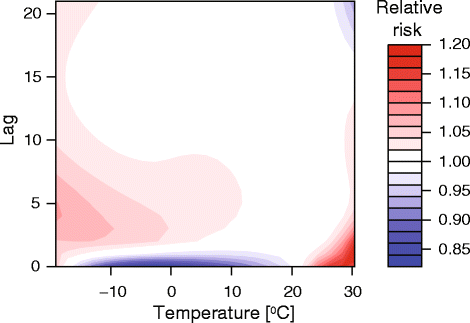
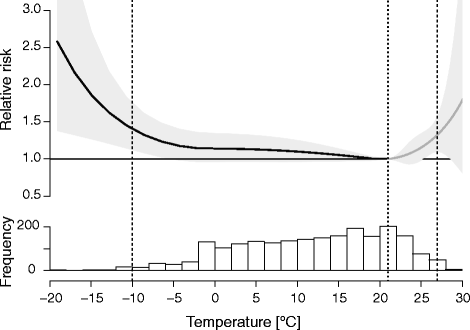
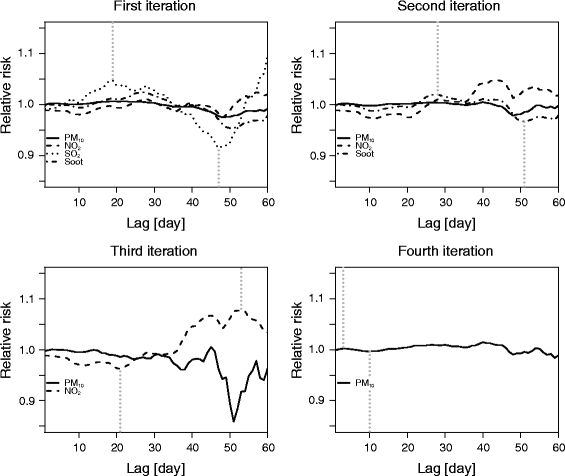
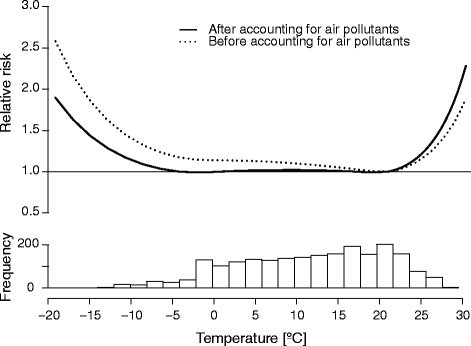
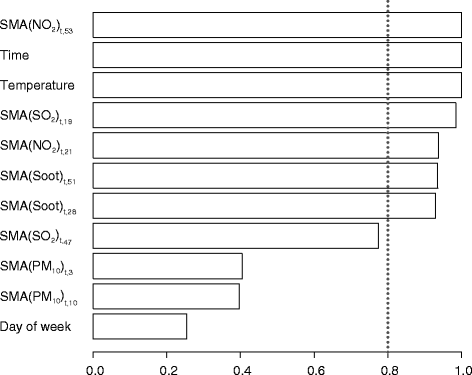
Similar articles
-
Part 2. Association of daily mortality with ambient air pollution, and effect modification by extremely high temperature in Wuhan, China.Res Rep Health Eff Inst. 2010 Nov;(154):91-217. Res Rep Health Eff Inst. 2010. PMID: 21446212
-
Part 5. Public health and air pollution in Asia (PAPA): a combined analysis of four studies of air pollution and mortality.Res Rep Health Eff Inst. 2010 Nov;(154):377-418. Res Rep Health Eff Inst. 2010. PMID: 21446215
-
Multicity study of air pollution and mortality in Latin America (the ESCALA study).Res Rep Health Eff Inst. 2012 Oct;(171):5-86. Res Rep Health Eff Inst. 2012. PMID: 23311234
-
Health effects of outdoor air pollution. Committee of the Environmental and Occupational Health Assembly of the American Thoracic Society.Am J Respir Crit Care Med. 1996 Jan;153(1):3-50. doi: 10.1164/ajrccm.153.1.8542133. Am J Respir Crit Care Med. 1996. PMID: 8542133 Review.
-
Air Pollution and Mortality in China.Adv Exp Med Biol. 2017;1017:103-121. doi: 10.1007/978-981-10-5657-4_5. Adv Exp Med Biol. 2017. PMID: 29177960 Review.
Cited by
-
From single to multivariable exposure models to translate climatic and air pollution effects into mortality risk. A customized application to the city of Rome, Italy.MethodsX. 2022 May 5;9:101717. doi: 10.1016/j.mex.2022.101717. eCollection 2022. MethodsX. 2022. PMID: 35620759 Free PMC article.
-
Effects of extreme temperatures on cardiovascular emergency hospitalizations in a Mediterranean region: a self-controlled case series study.Environ Health. 2017 Apr 4;16(1):32. doi: 10.1186/s12940-017-0238-0. Environ Health. 2017. PMID: 28376798 Free PMC article.
-
Interaction Effects of Air Pollution and Climatic Factors on Circulatory and Respiratory Mortality in Xi'an, China between 2014 and 2016.Int J Environ Res Public Health. 2020 Dec 3;17(23):9027. doi: 10.3390/ijerph17239027. Int J Environ Res Public Health. 2020. PMID: 33287400 Free PMC article.
-
Increased vulnerability of COPD patient groups to urban climate in view of global warming.Int J Chron Obstruct Pulmon Dis. 2018 Oct 23;13:3493-3501. doi: 10.2147/COPD.S174148. eCollection 2018. Int J Chron Obstruct Pulmon Dis. 2018. PMID: 30498339 Free PMC article.
References
-
- Analitis A, Michelozzi P, D’Ippoliti D, de Donato F, Menne B, Matthies F, Atkinson RW, Iñiguez C, Basagaña X, Schneider A, Lefranc A. Effects of heat waves on mortality: effect modification and confounding by air pollutants. Epidemiology. 2014;25:15–22. doi: 10.1097/EDE.0b013e31828ac01b. - DOI - PubMed
MeSH terms
Substances
LinkOut - more resources
Full Text Sources
Other Literature Sources
Medical

